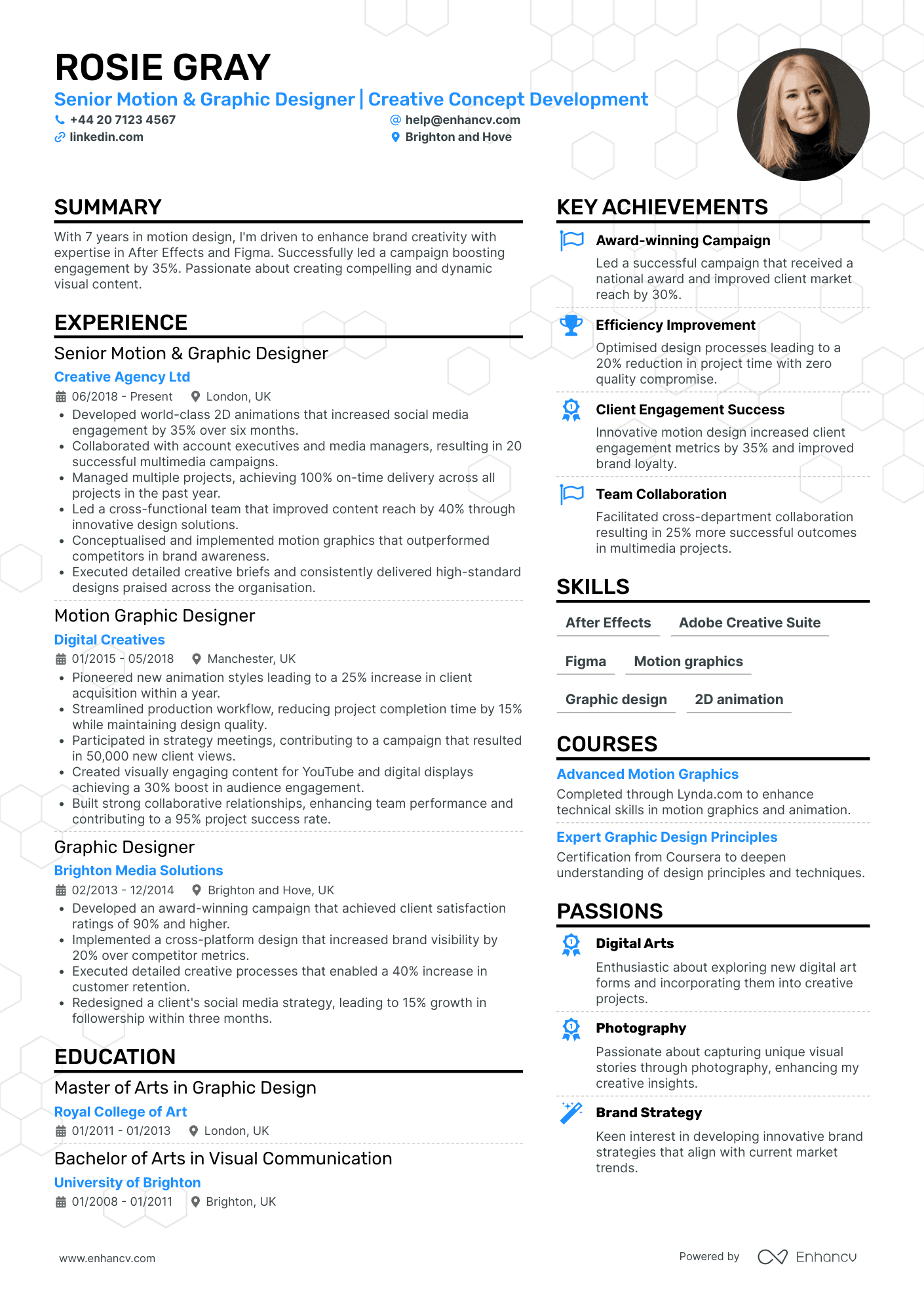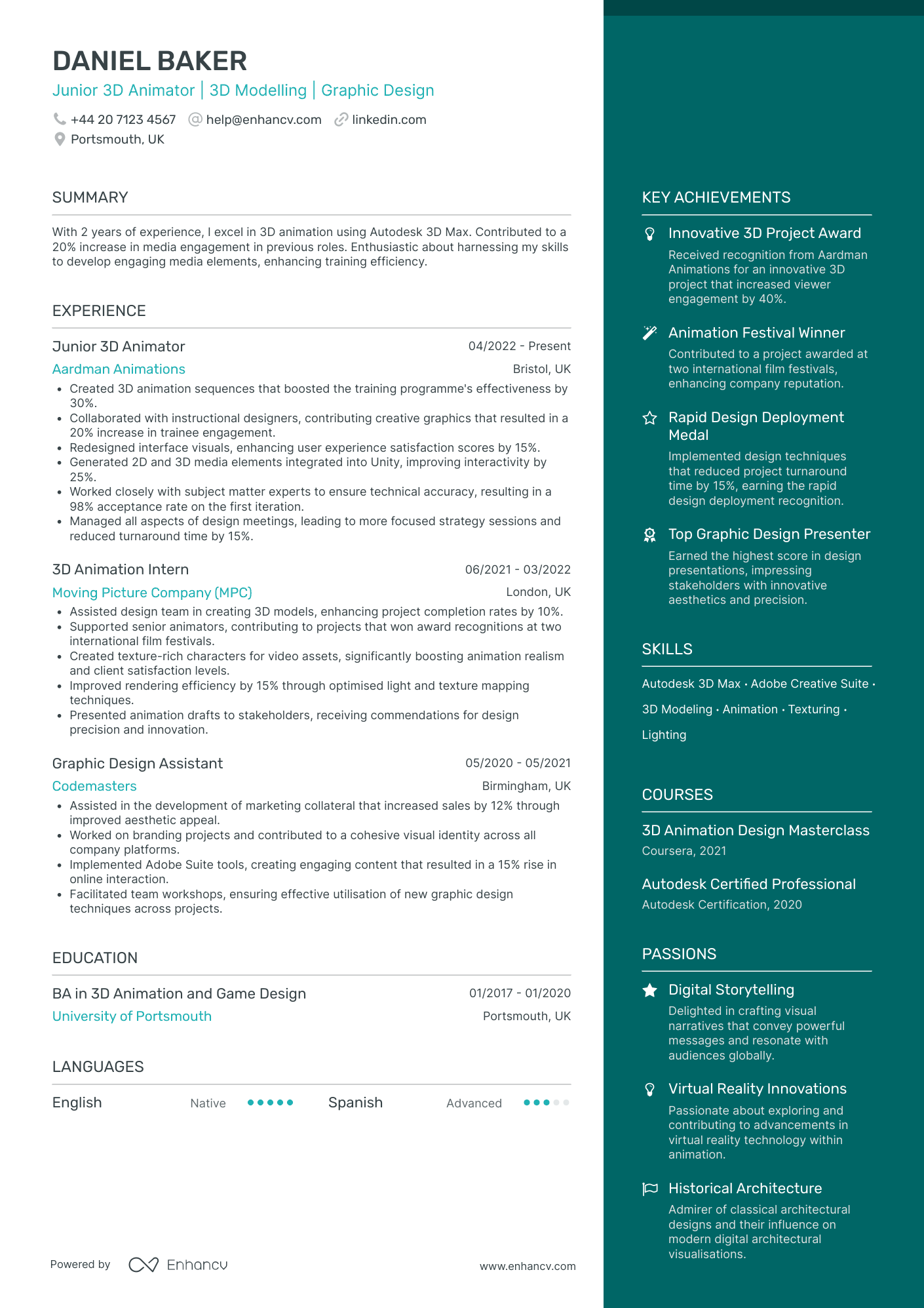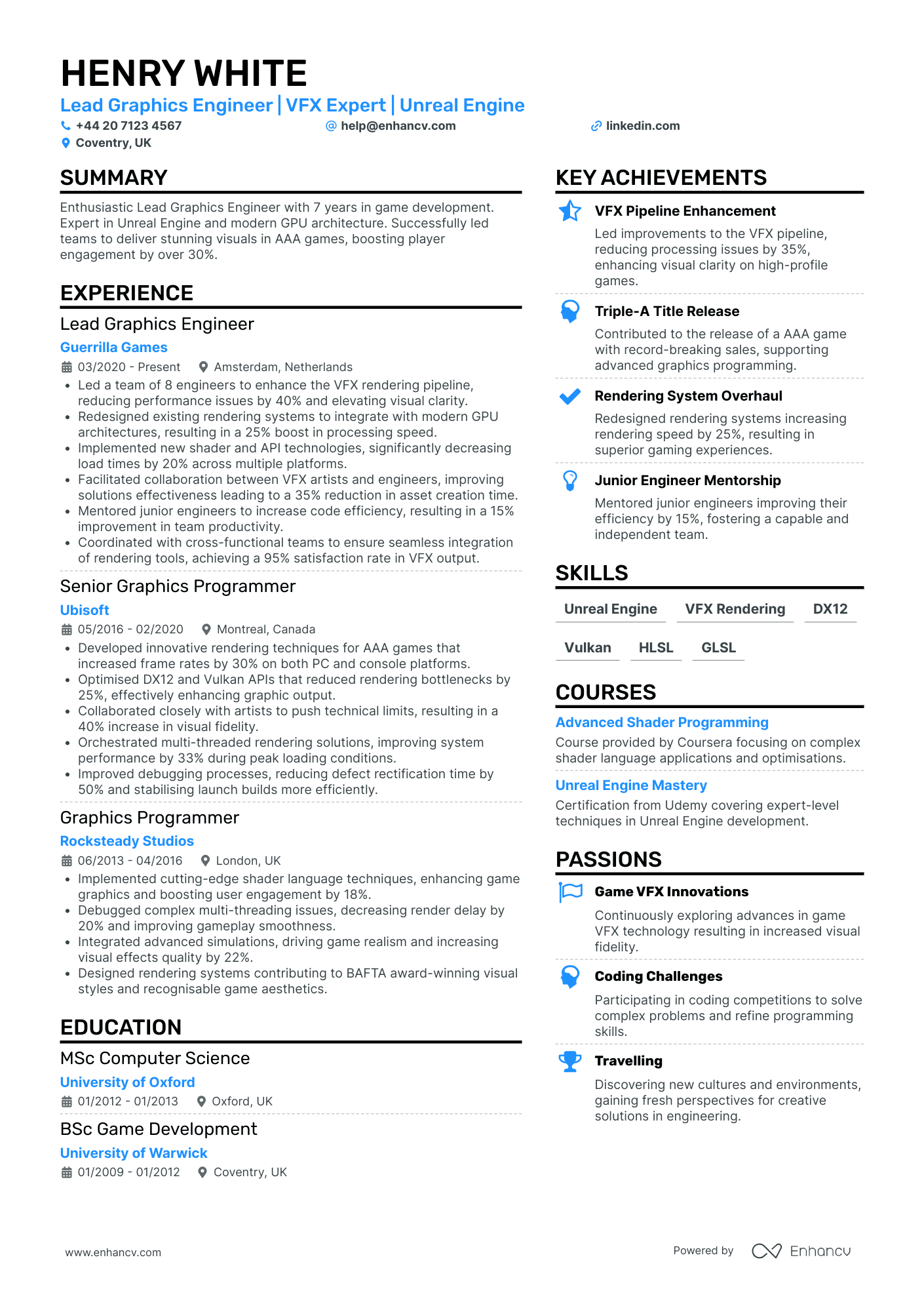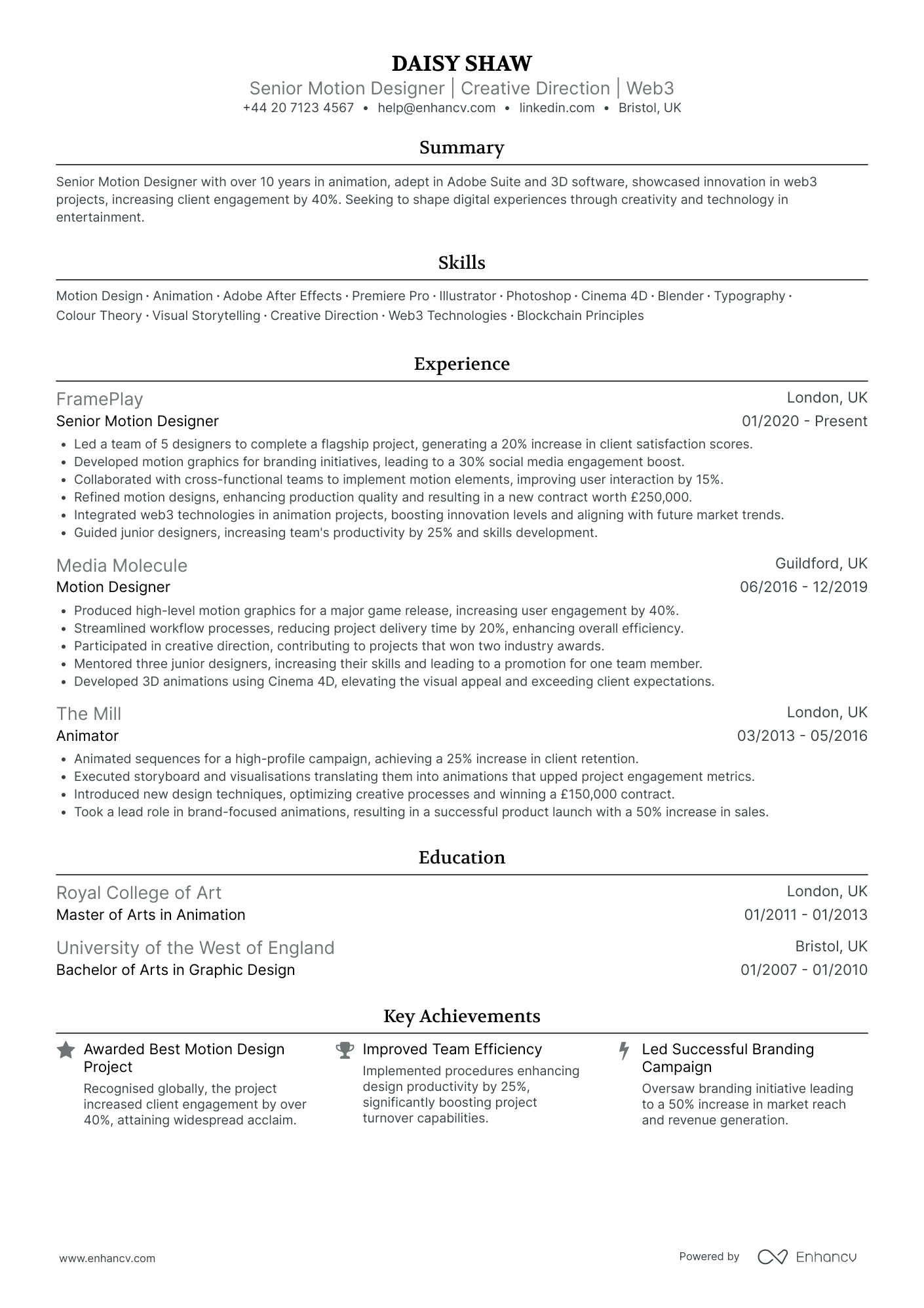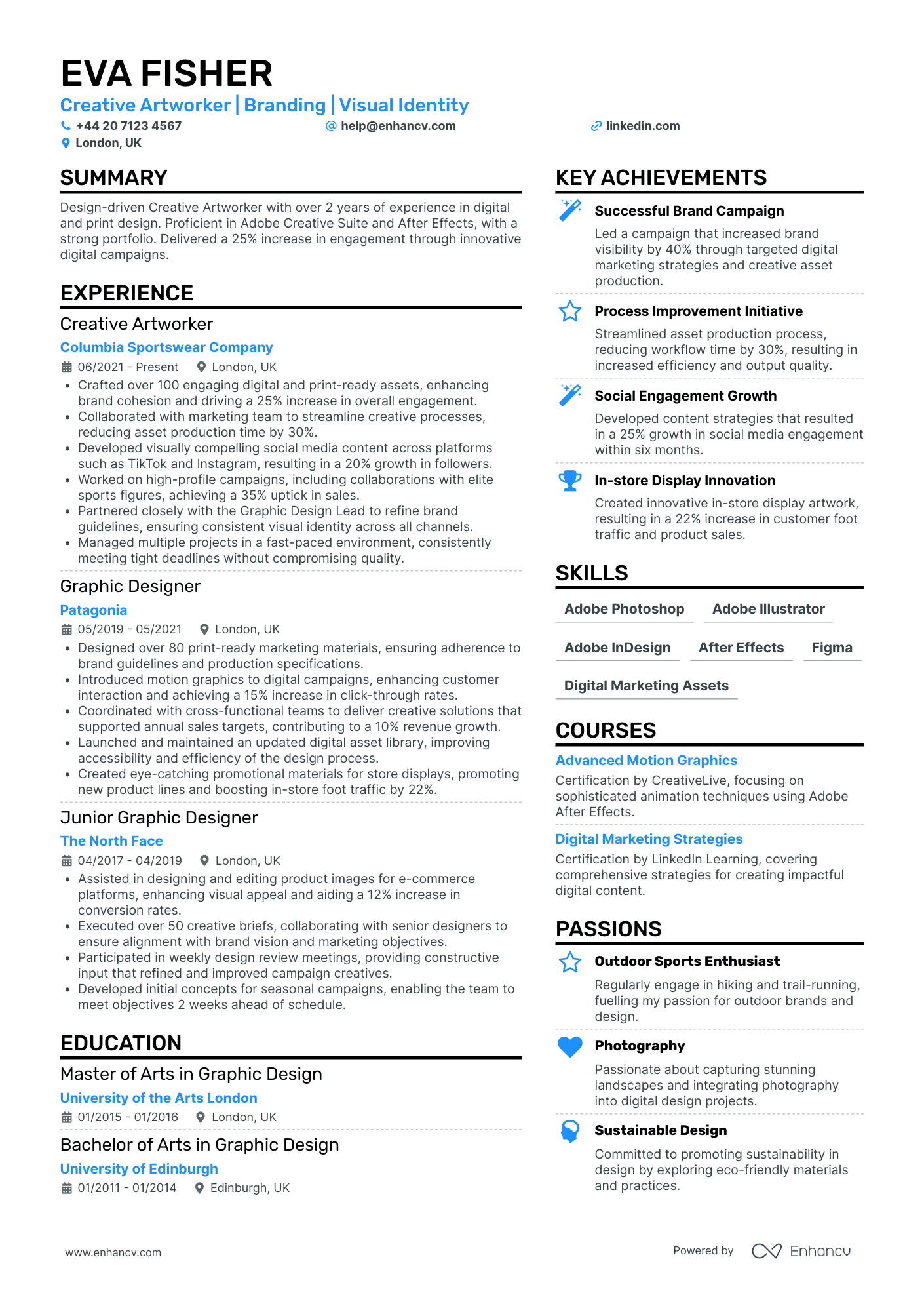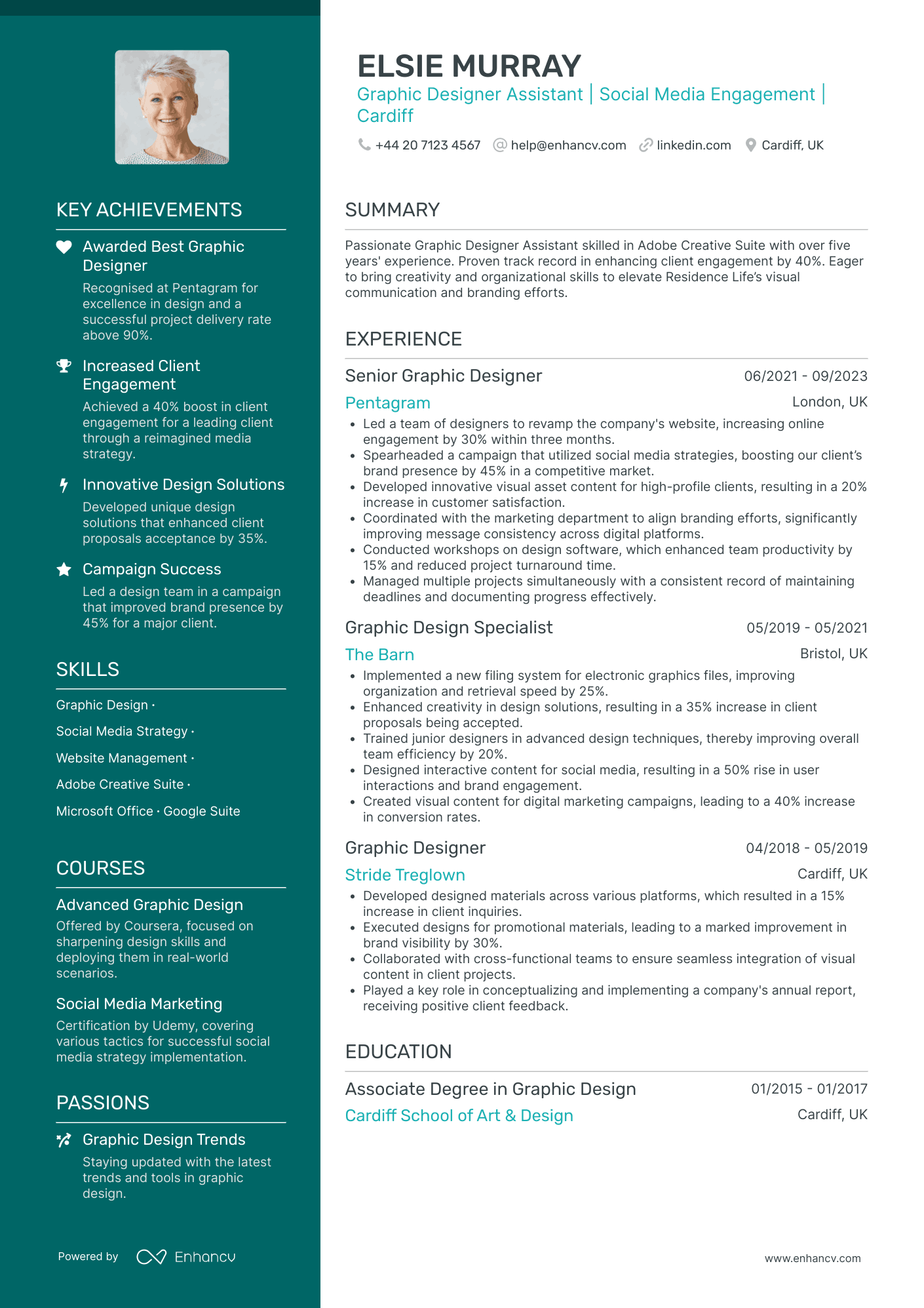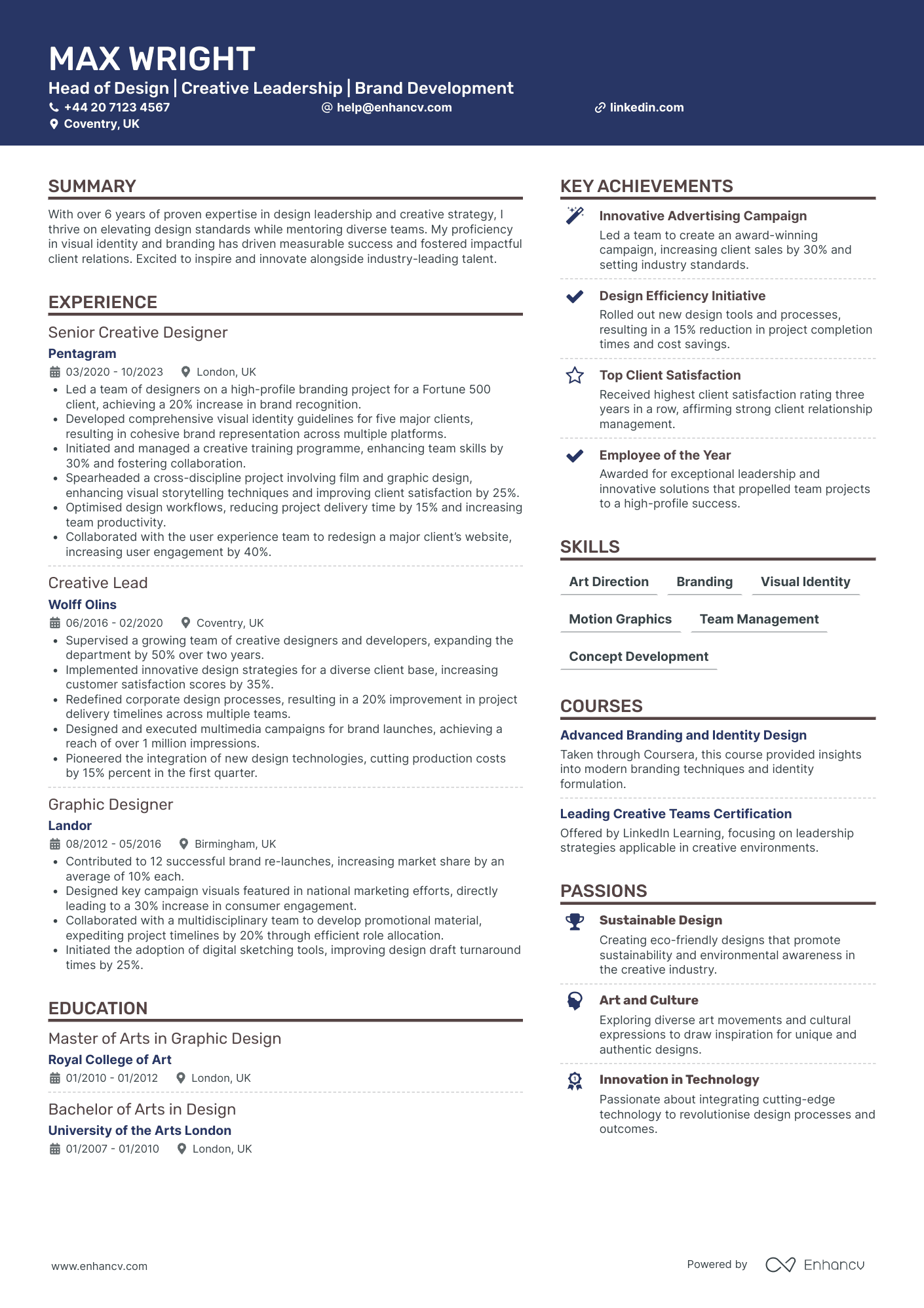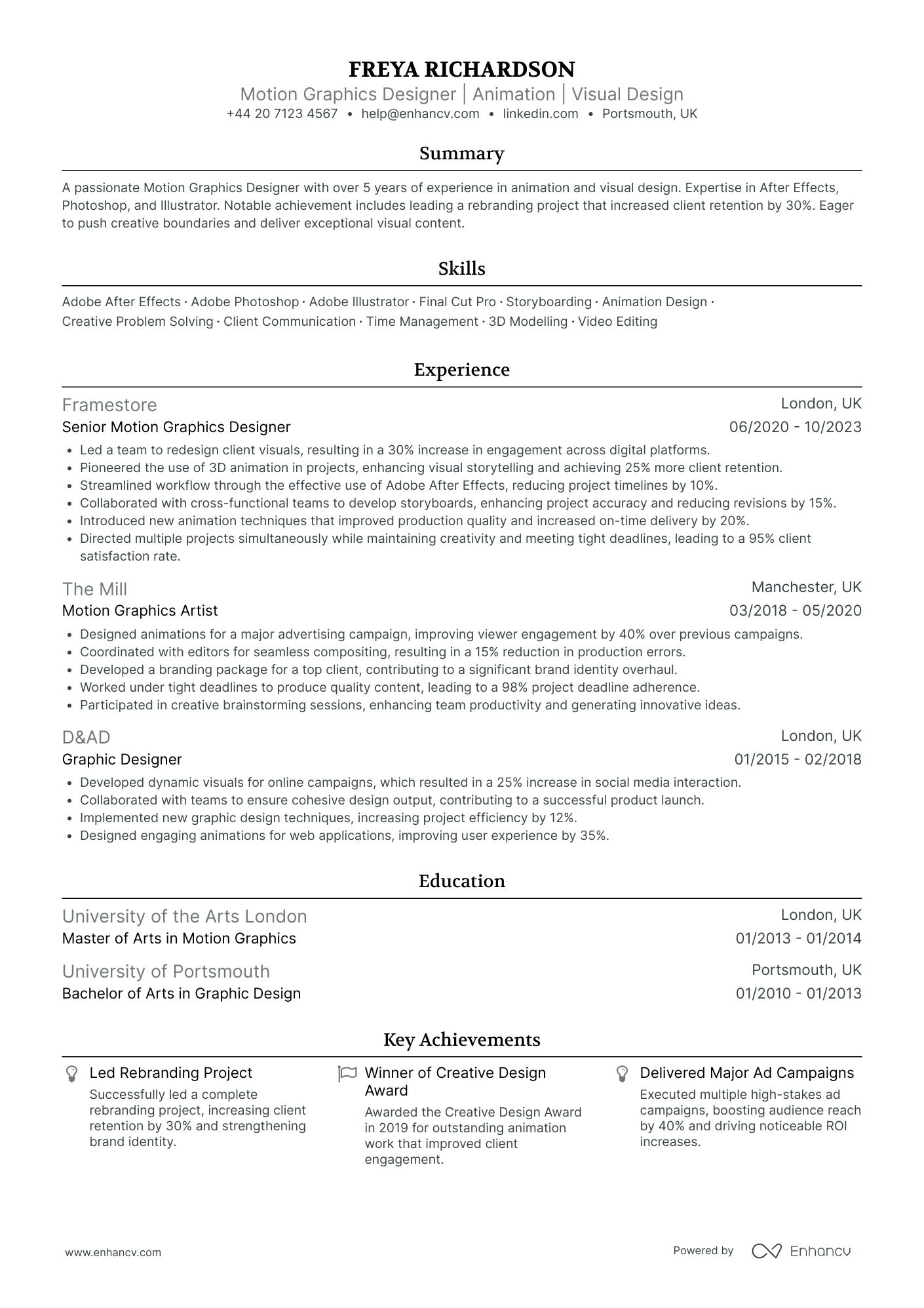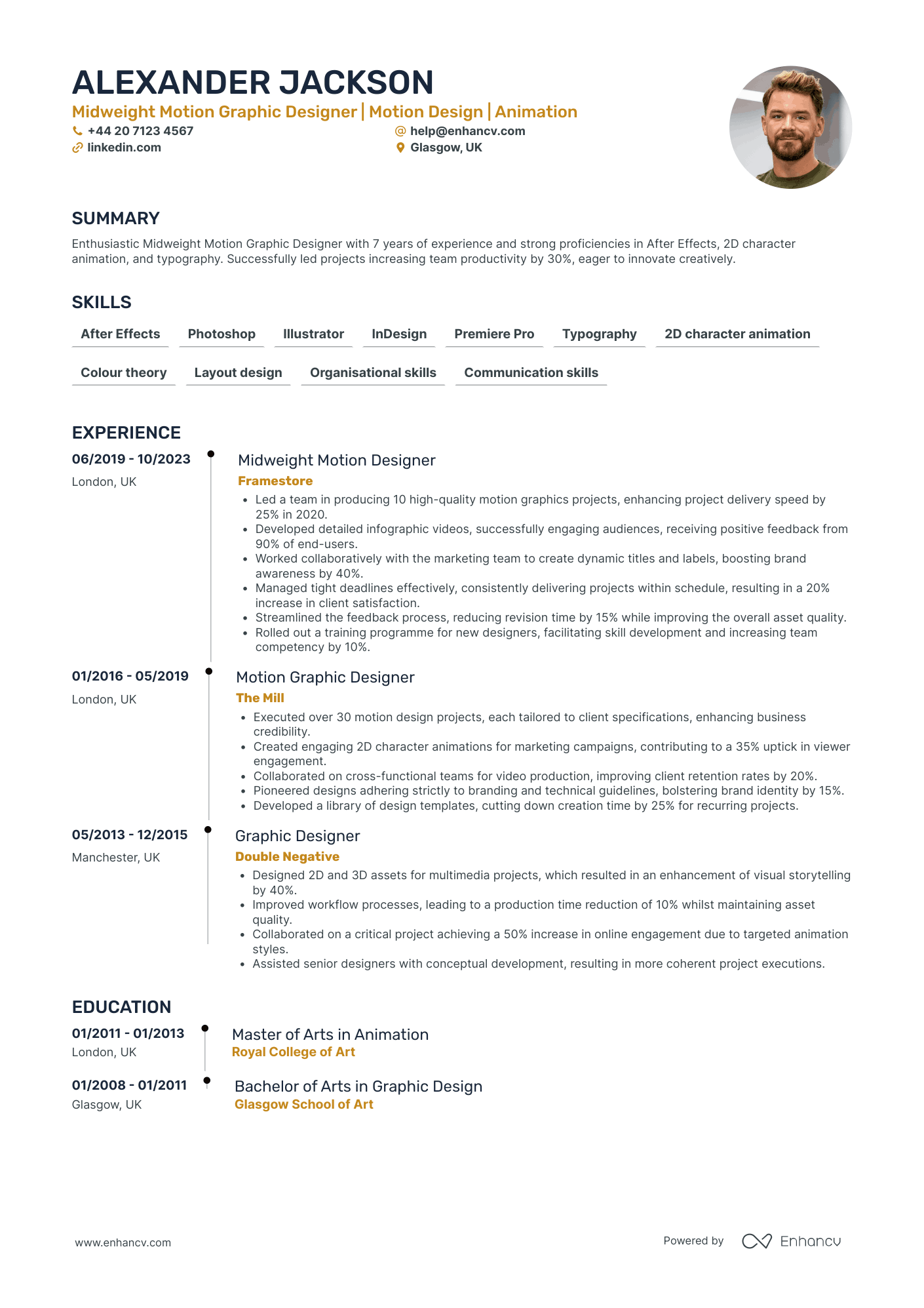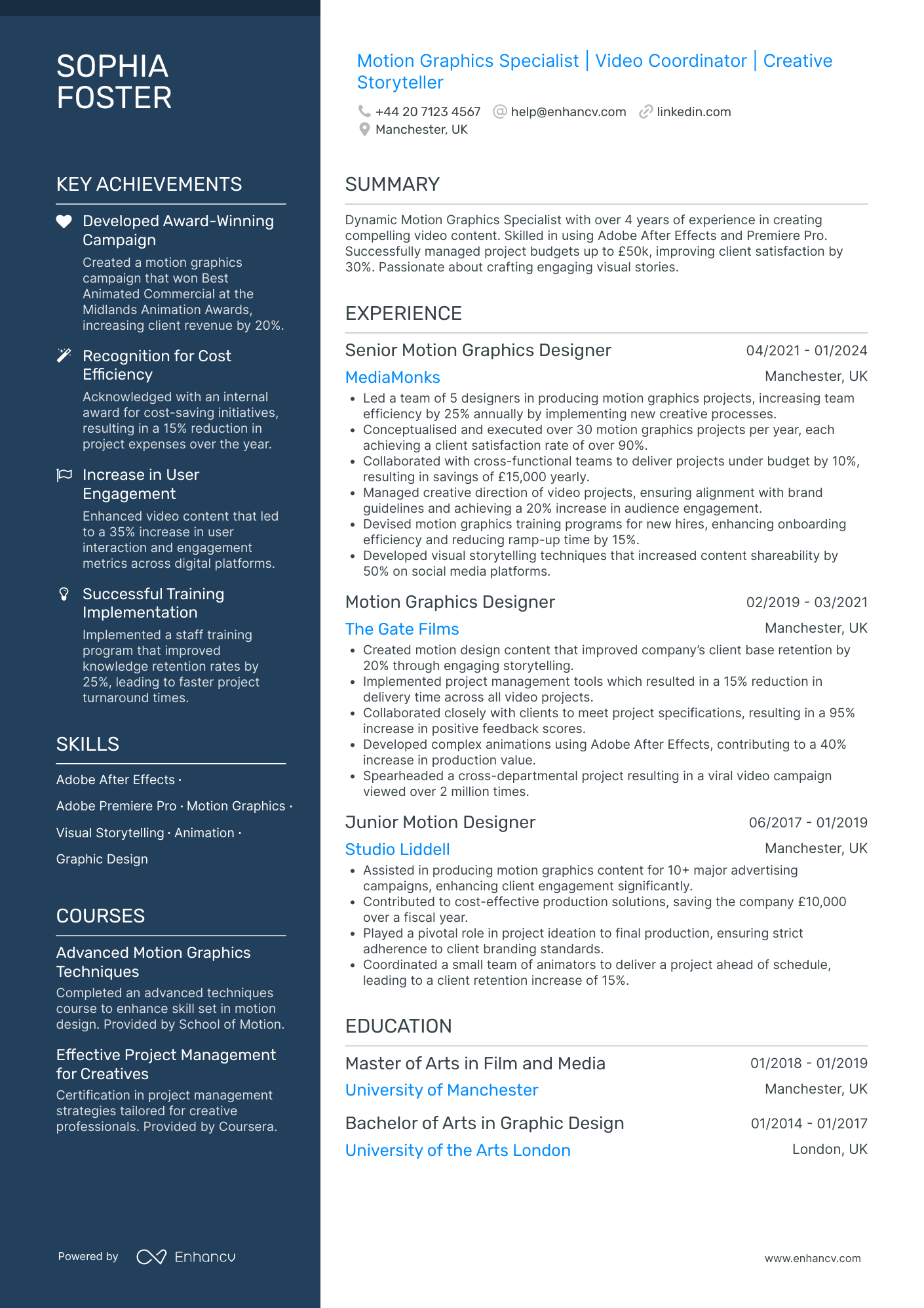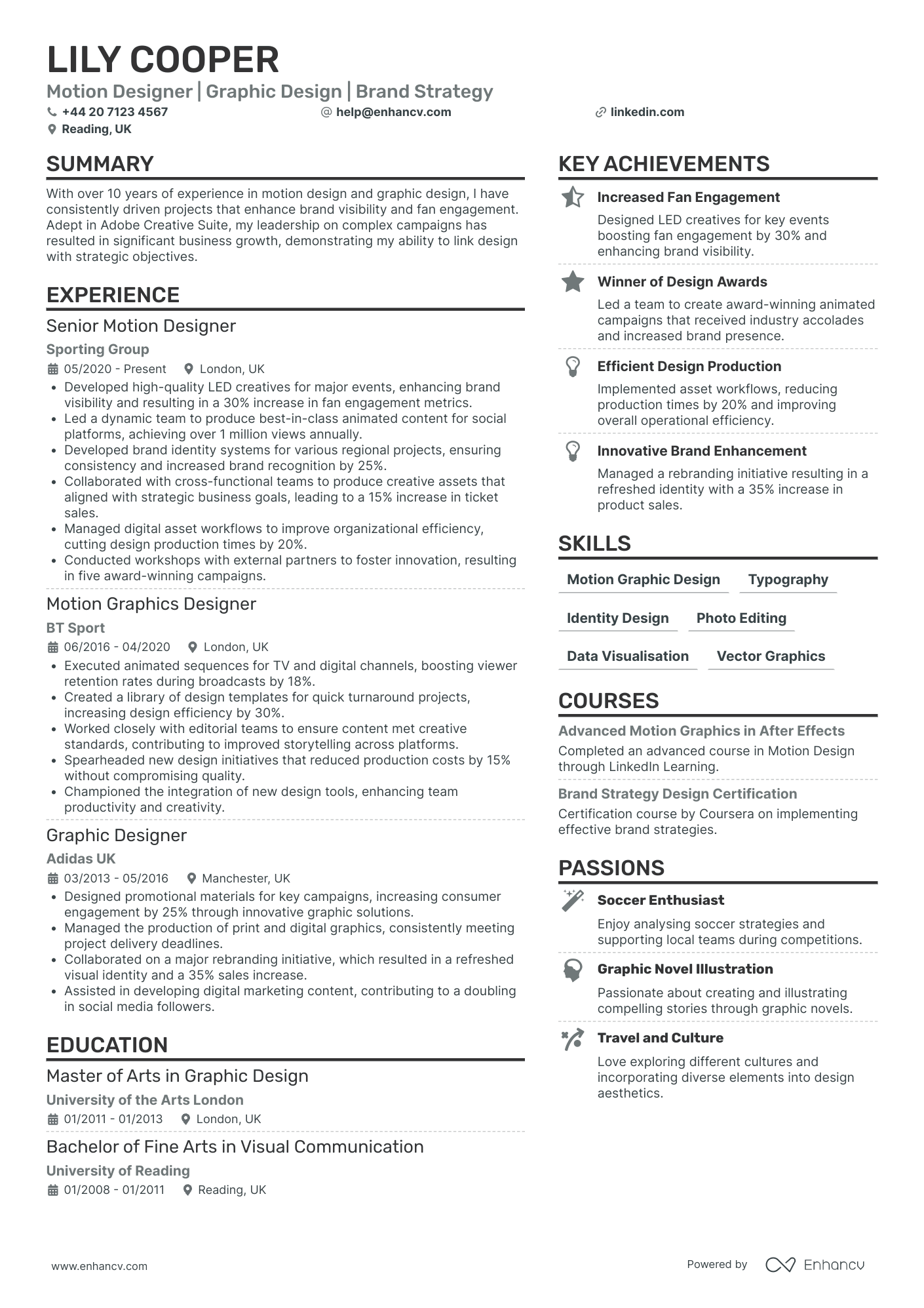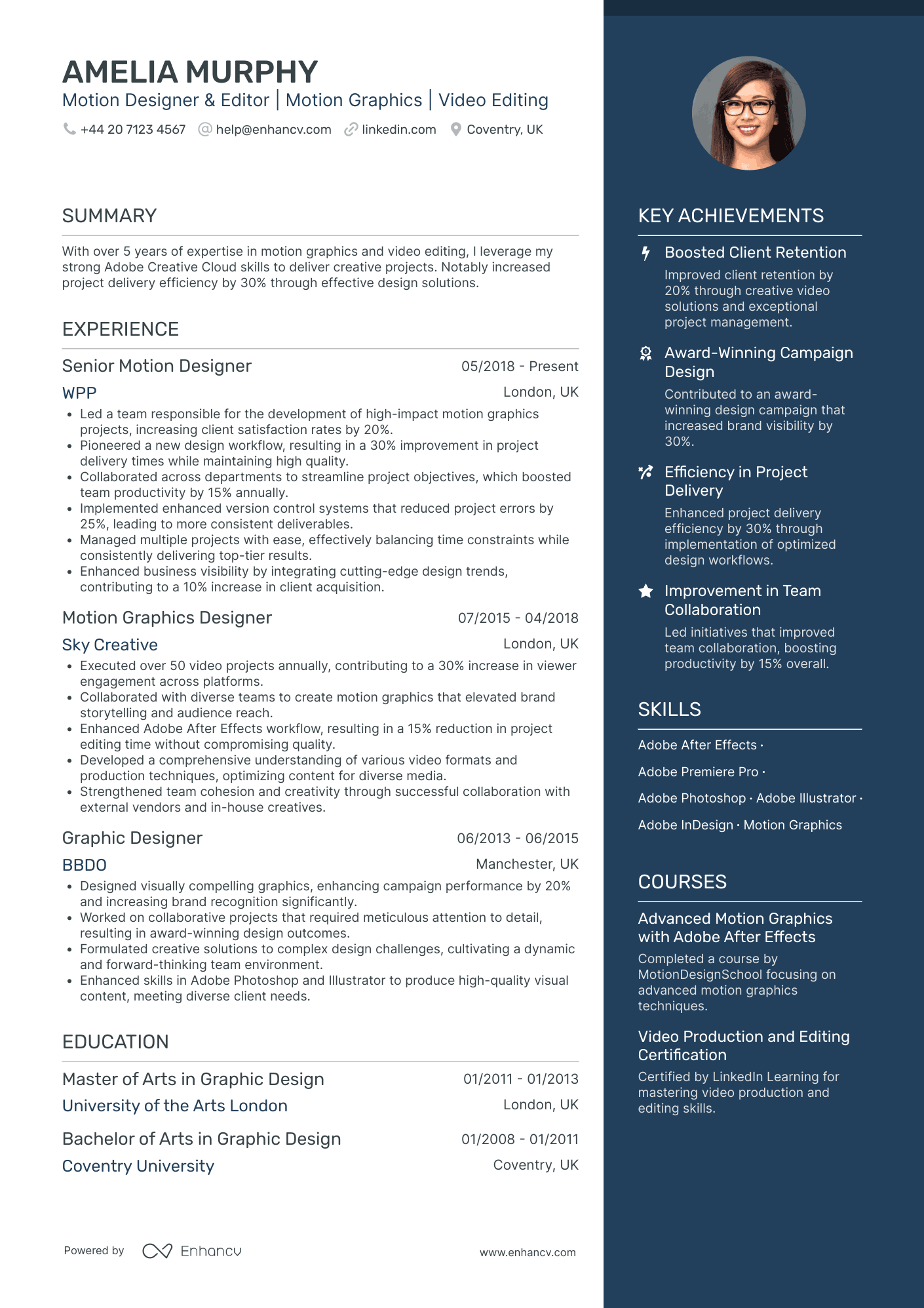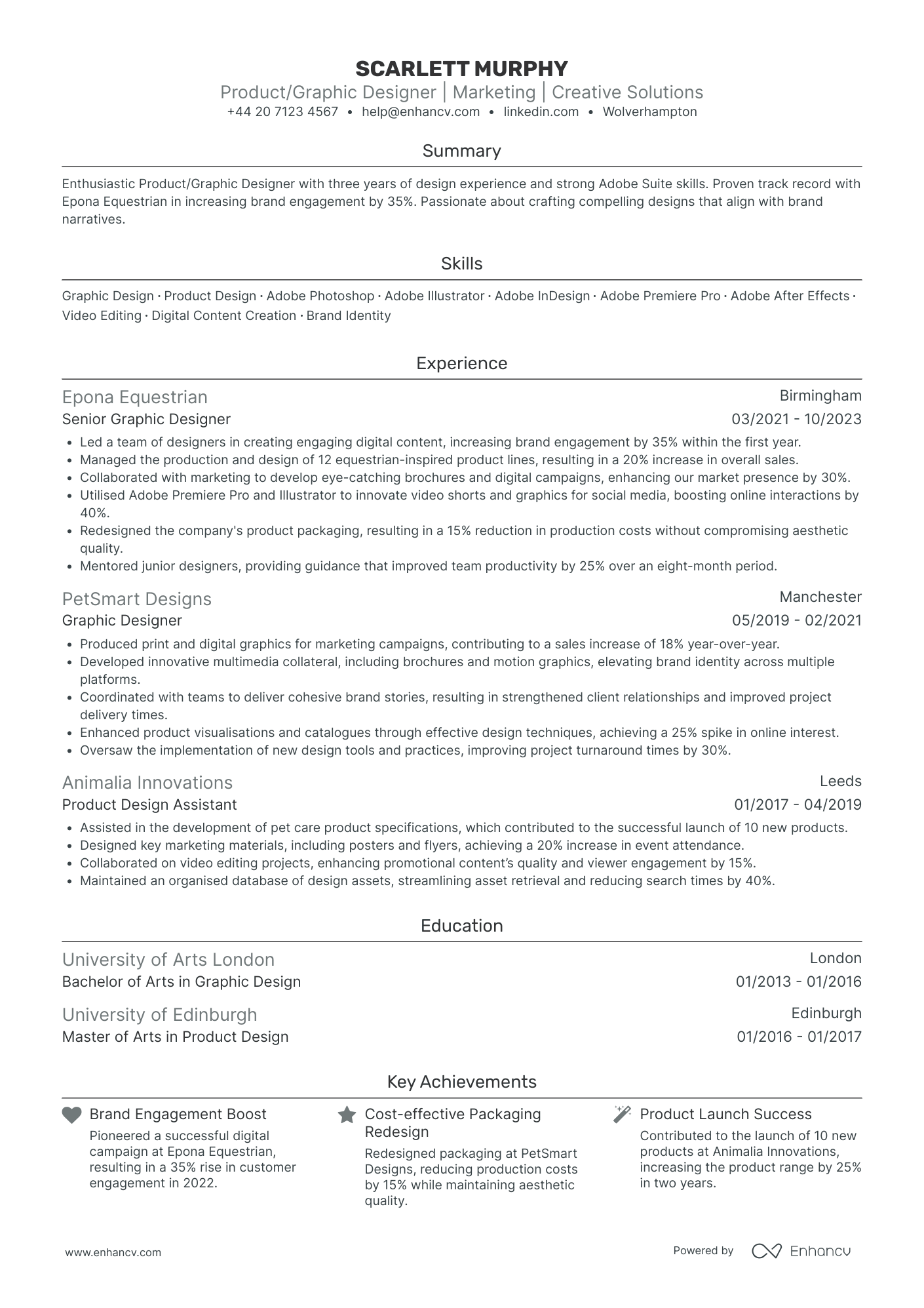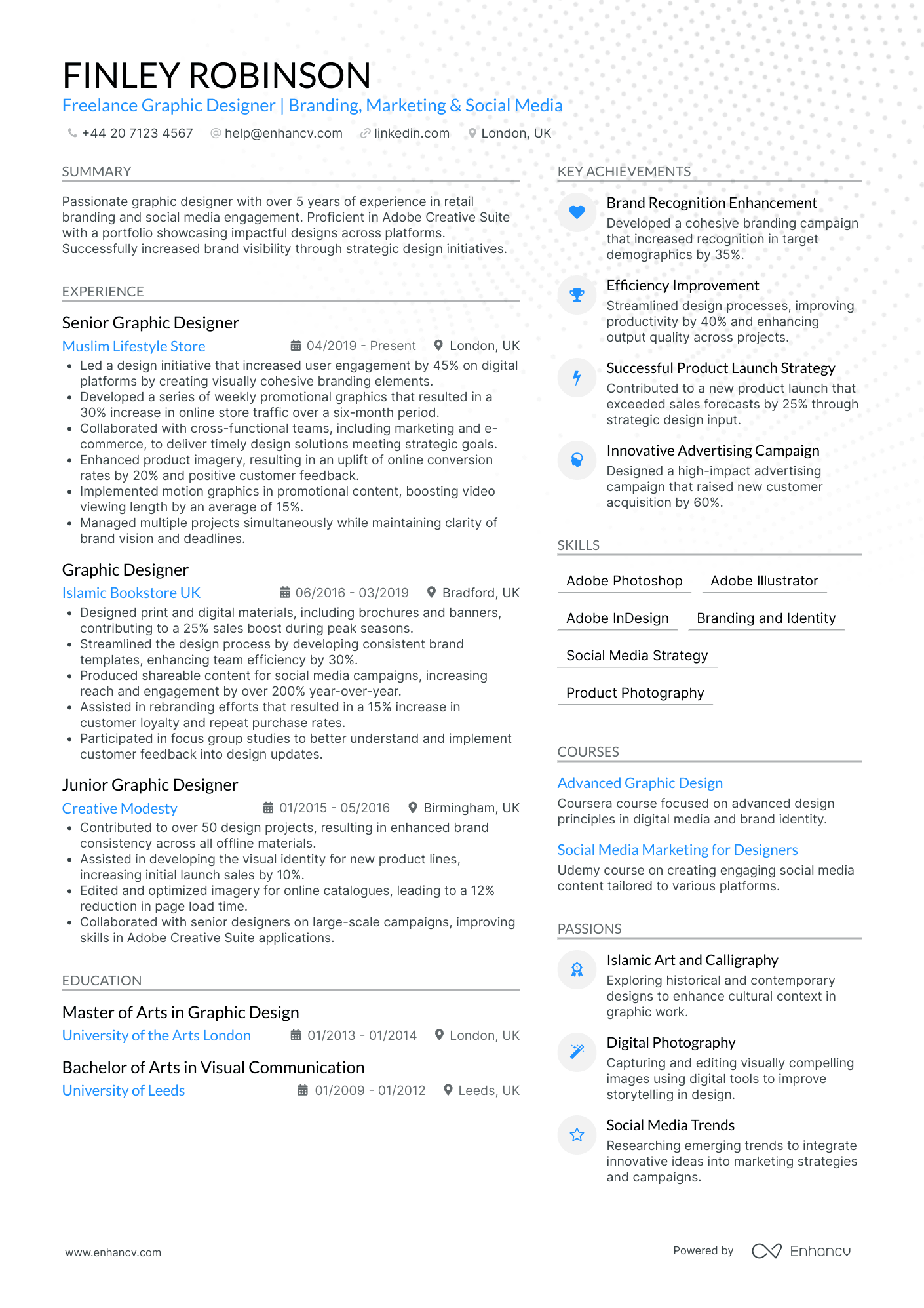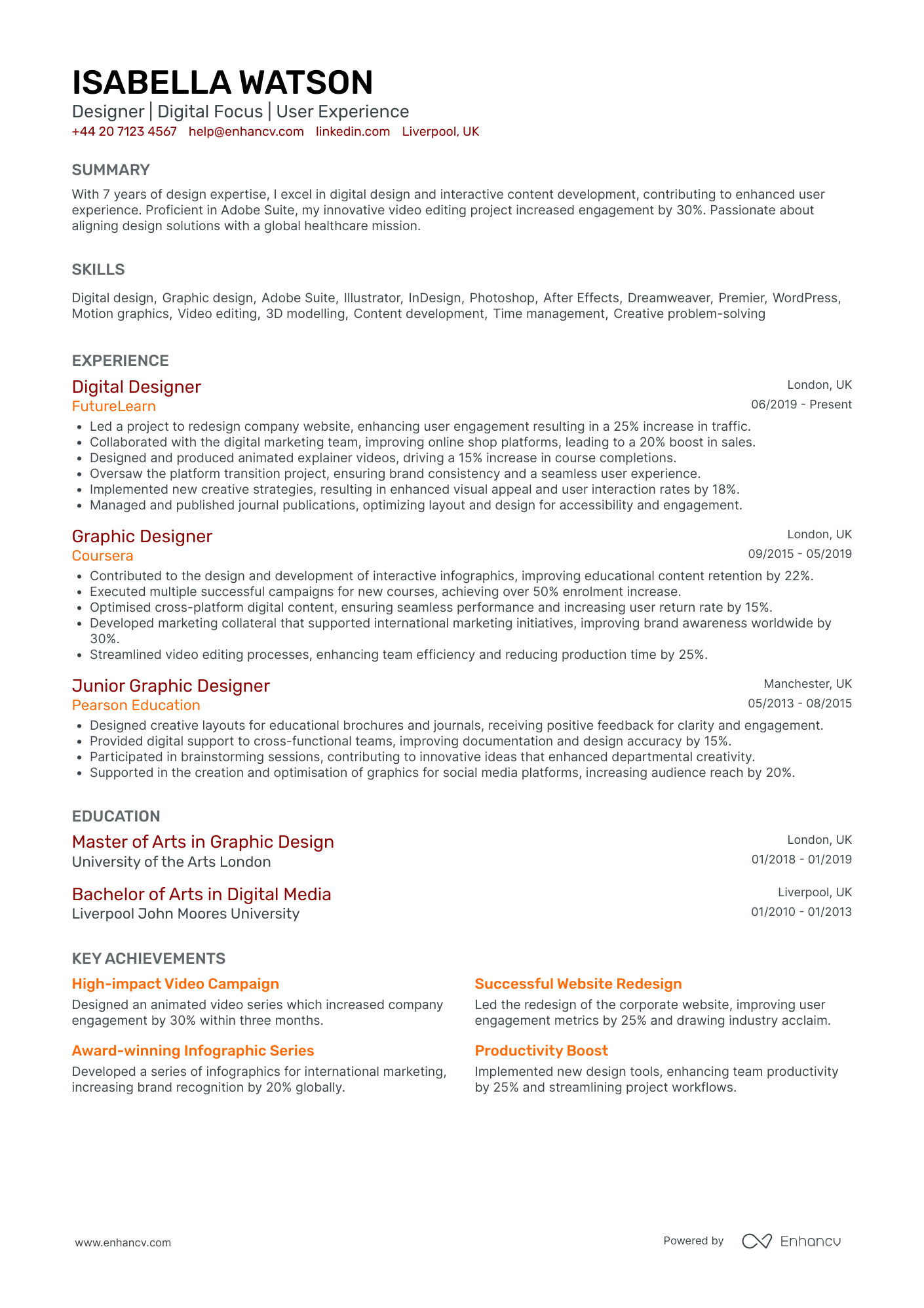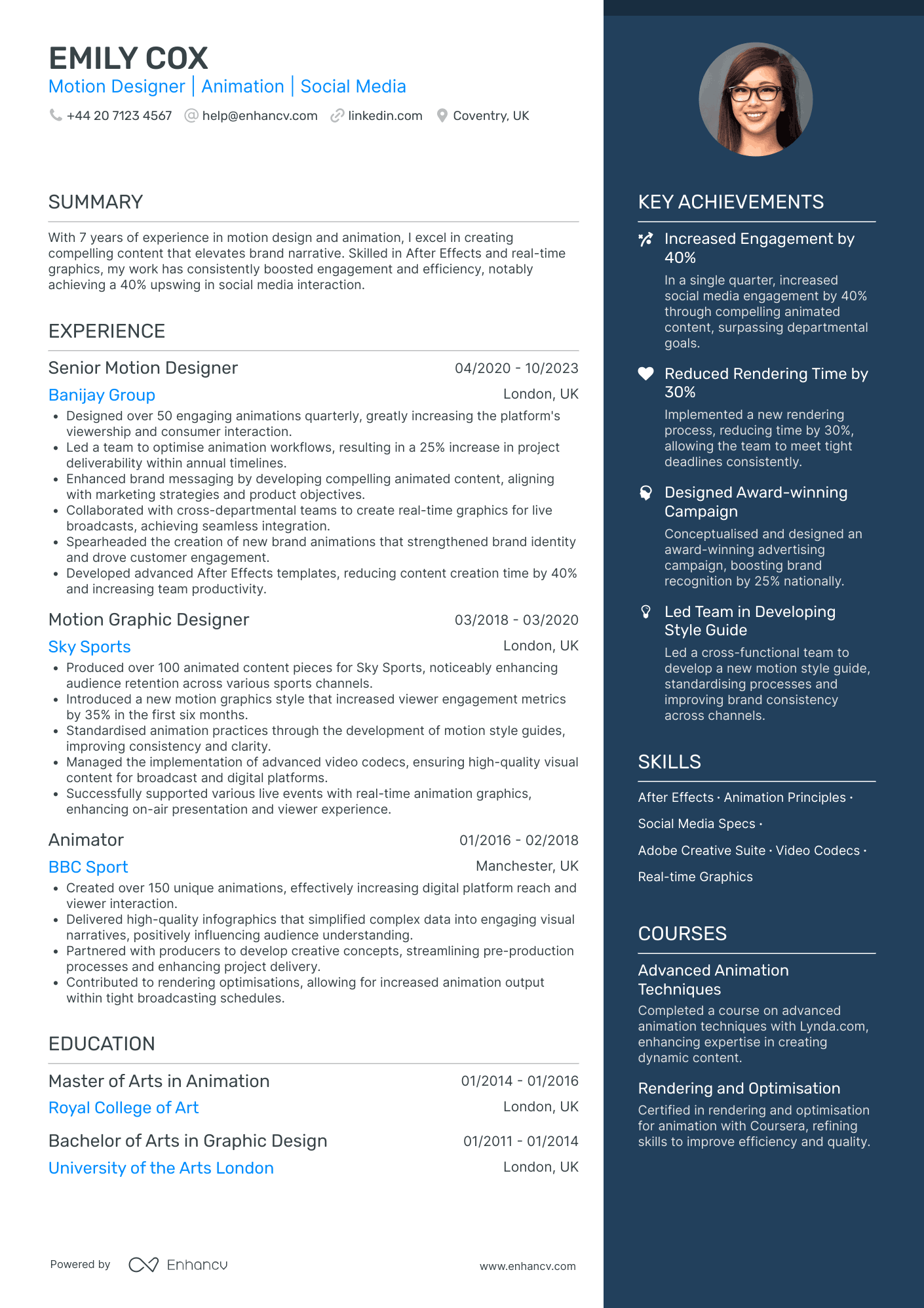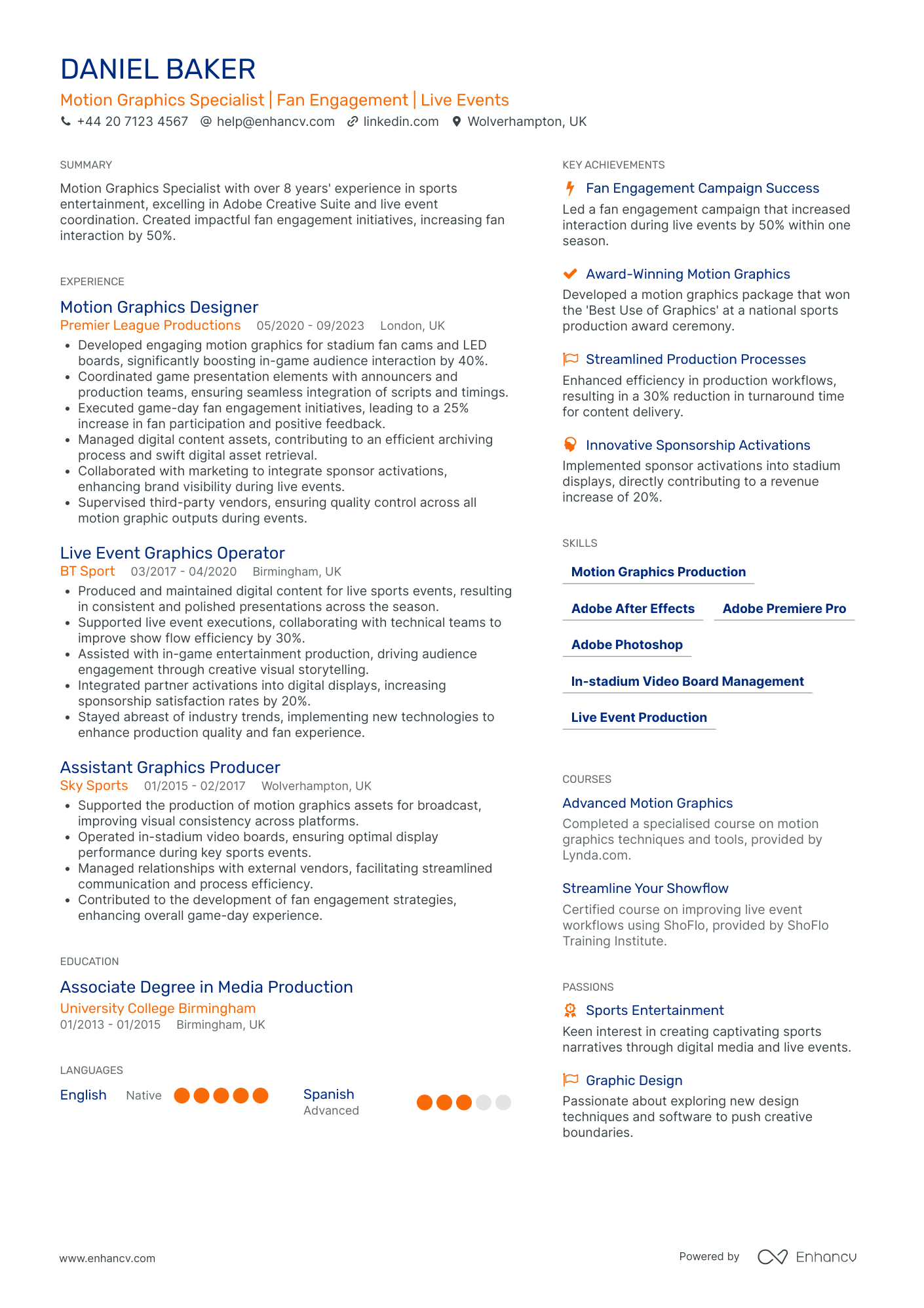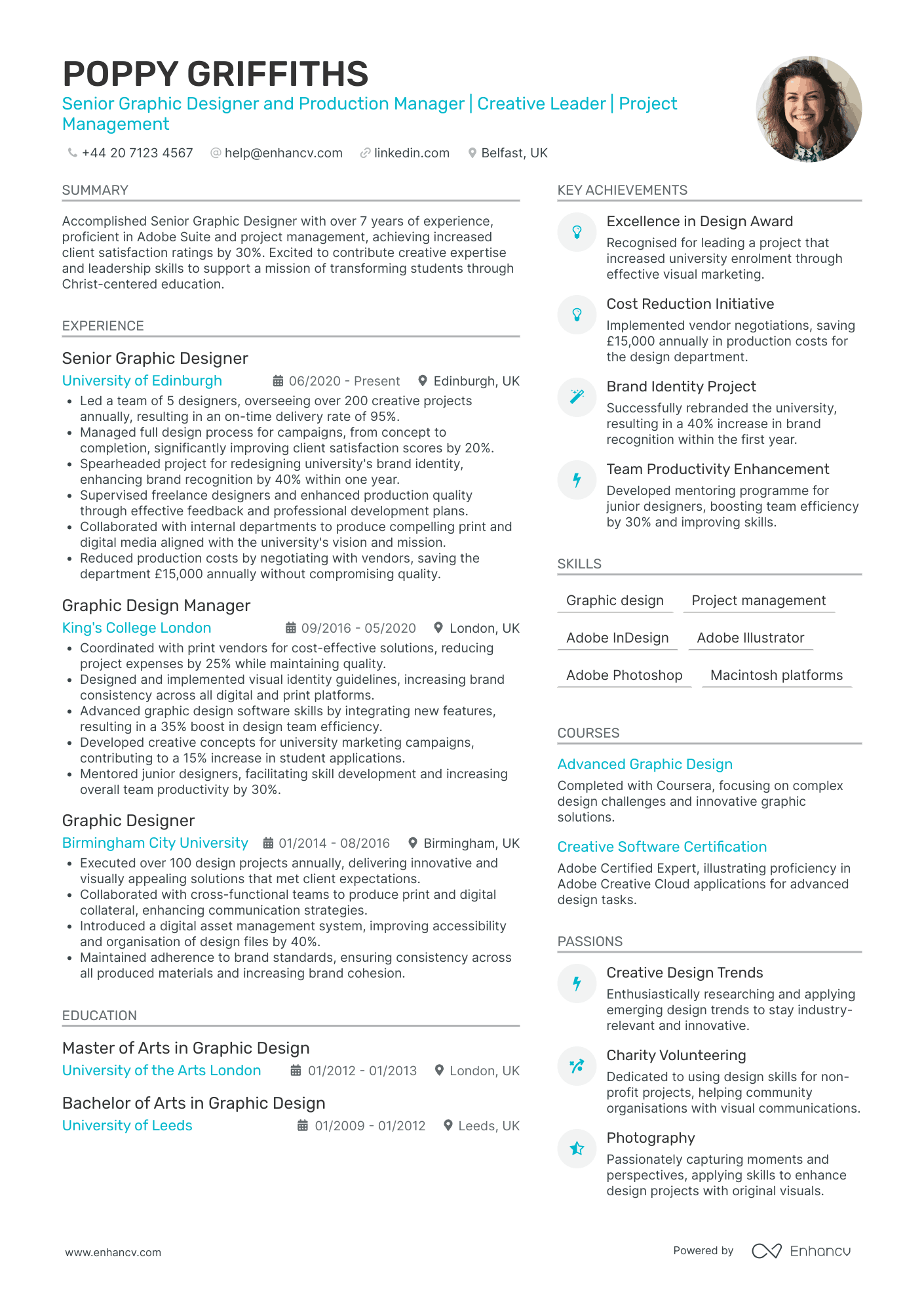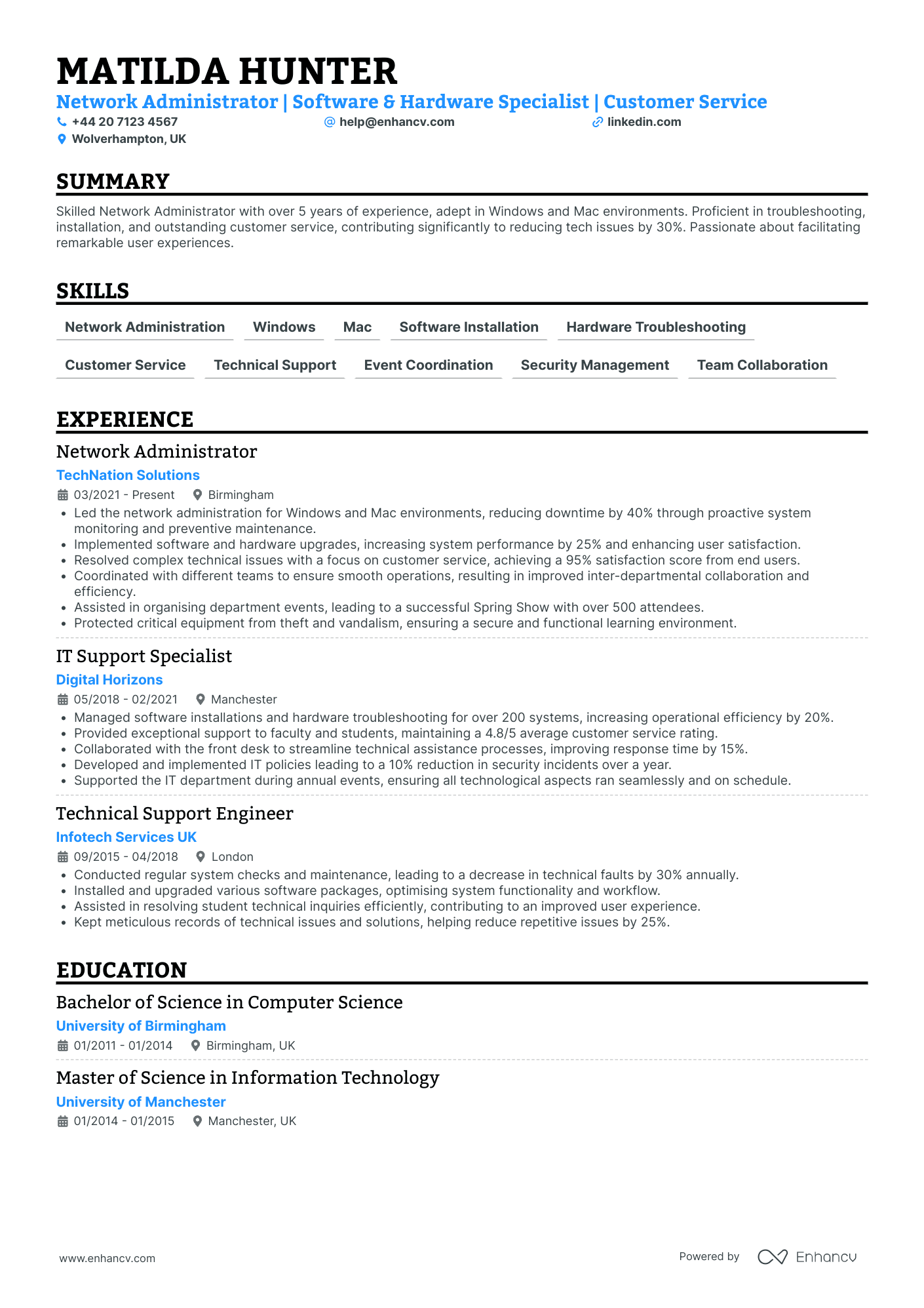One of the specific CV challenges you may encounter in motion graphics is accurately tracking fast-moving objects within a complex scene. Our comprehensive guide offers step-by-step techniques and software recommendations that can help you overcome this issue, enhancing the precision and efficiency of your motion tracking.
- Design and format your professional motion graphics CV;
- Curate your key contact information, skills, and achievements throughout your CV sections;
- Ensure your profile stays competitive by studying other industry-leading motion graphics CVs;
- Create a great CV even if you happen to have less professional experience, or switching fields.
When writing your motion graphics CV, you may need plenty of insights from hiring managers. We have prepared industry-leading advice in the form of our relevant CV guides.
CV examples for motion graphics
By Experience
Senior Motion Graphics Designer
- Structured Career Growth with Increasing Responsibility - Rosie's career trajectory reflects a clear path of progression, moving from a Graphic Designer to a Senior Motion & Graphic Designer. Each role involves more significant responsibilities and showcases her professional development and commitment to her field. This highlights her ability to take on leadership roles and her ambition to drive creative projects forward.
- Diverse Skill Set Highlighting Essential Tools - Her CV prominently features industry-relevant skills like After Effects, Adobe Creative Suite, and Figma, which are critical in the design world. Including these tools signifies her technical proficiency necessary for high-level design and animation work, making her a valuable asset to any creative team looking to push the boundaries of visual content.
- Evidence of Cross-Functional and Collaborative Strength - Rosie's cross-functional experience is evident as she collaborates with account executives and media managers leading to successful campaigns. Her ability to facilitate teamwork and interdepartmental collaboration has resulted in improved multimedia project outcomes. This versatility is crucial in dynamic agency settings.
Junior Motion Graphics Animator
- Emphasis on Career Growth and Development - Daniel’s career trajectory illustrates significant growth, evolving from a Graphic Design Assistant to a Junior 3D Animator. This progression highlights his commitment to advancing his technical skills within the animation and design industry, while gaining experience in reputable companies like Aardman Animations and the Moving Picture Company.
- Effective Use of Industry-Specific Tools - The CV effectively emphasizes Daniel's proficiency with key industry tools and software, such as Autodesk 3D Max, Adobe Creative Suite, and Unity. By listing such tools comprehensively, the document showcases his technical depth, indicating that he possesses the necessary expertise to excel in the 3D animation and graphic design fields.
- Achievements with a Focus on Business Impact - Strategic presentation of achievements reveals their business relevance, not just numerical gains. For example, projects leading to a 20% increase in trainee engagement and receiving awards at international film festivals underscore Daniel's capacity to drive significant engagement and enhance an organization's reputation through his animation work.
Lead Motion Graphics Animator
- Exceptional Leadership and Mentorship - The CV emphasizes Henry White's strong leadership abilities and commitment to developing talent, highlighted by his role in mentoring junior engineers, which resulted in a noticeable 15% increase in team productivity. This focus on nurturing skill growth not only enhances team efficiency but also fosters a culture of continuous improvement and capability building.
- Strategic Adaptation and Implementation - A commendable aspect of the CV is its illustration of adaptability through the integration of the latest technologies in graphics and VFX. His experience in employing advanced shader and API technologies to overcome platform load times and enhance visual output showcases an aptitude for strategic adaptation to industry innovations, positioning projects for success.
- Quantifiable Business Outcomes - Henry’s achievements are not just technical wins but impactful on business scales, effectively illustrating the significance of his contributions. The CV mentions performance improvements and reduced processing issues resulting from his work, translating into substantial boosts in visual clarity and player engagement, which are critical metrics in the competitive AAA game industry.
Motion Graphics Team Lead
- Clear presentation of skills and tools - The CV effectively enumerates a comprehensive set of technical skills including Adobe Suite and 3D software such as Cinema 4D and Blender, directly establishing the candidate's qualifications for a Senior Motion Designer role. It also showcases expertise in innovative areas like Web3 technologies, emphasizing the candidate's relevance in current and emerging trends.
- Continuous career growth and adaptability - Daisy’s career trajectory shows a linear progression from roles such as Animator to Senior Motion Designer, with notable promotions and leadership responsibilities along the way. This trajectory reflects a strong capacity for adaptation and growth within the dynamic fields of motion design and content animation.
- Impactful achievements and business relevance - The candidate's accomplishments are presented with quantifiable impacts, such as improving client satisfaction scores and boosting social media engagement. These achievements demonstrate not only technical skill but also the ability to translate those skills into meaningful business outcomes, enhancing the relevance of her profile to potential employers.
Motion Graphics Creative Director
- Structured Professional Growth - Eva Fisher’s career trajectory displays a clear pattern of growth and upward mobility within the creative design industry. Transitioning from a Junior Graphic Designer at The North Face to her current role as Creative Artworker at Columbia Sportswear Company, her journey showcases a steady climb through increasingly complex and impactful roles.
- Impactful Collaborations and Campaign Success - The CV highlights significant achievements, such as a 35% increase in sales through high-profile campaigns and a 25% growth in engagement via innovative digital strategies. These achievements are not mere numbers but indicative of Eva's ability to contribute strategic value to large-scale, cross-functional projects that drive substantial business outcomes.
- Comprehensive Skill Set and Certifications - Her proficiency in a variety of design tools, including Adobe Creative Suite and After Effects, combined with certifications in Advanced Motion Graphics and Digital Marketing Strategies, underscores Eva's deep technical knowledge and readiness to handle complex design challenges. Her participation in continuous learning initiatives reveals a commitment to maintaining cutting-edge skills in visual design and marketing.
Assistant Motion Graphics Designer
- Skills Integration and Technical Proficiency - The CV effectively highlights Elsie's proficiency in using a broad range of tools integral to graphic design, such as Adobe Creative Suite and Microsoft Office. This demonstrates her capability to leverage industry-specific methodologies and illustrates a robust technical depth, making her a valuable asset to any design team.
- Career Trajectory and Professional Growth - Elsie's career has seen a clear growth trajectory, moving from a Graphic Design Specialist to a Senior Graphic Designer. This progression reflects her increasing responsibility and expertise within the industry, showcasing her ability to take on more complex roles and projects with success in diverse company settings.
- Achievements with Business Impact - The CV details measurable achievements that effectively demonstrate Elsie's impact on the organizations she has worked for. Each stated accomplishment includes specific metrics, such as a 45% boost in a client's brand presence or a 20% increase in customer satisfaction, indicating not only her design proficiency but also her ability to drive meaningful business outcomes.
Head of Motion Graphics
- Clarity and Structure - Max Wright's CV exhibits exceptional clarity and organization, beginning with a succinct header that instantly communicates the candidate’s role and contact information. This is followed by a well-structured summary and detailed sections for experience, education, and skills, making it easy for recruiters to extract key details without sifting through unnecessary information.
- Career Growth and Industry Experience - The CV illustrates a well-defined career trajectory, showcasing Max's progression from Graphic Designer to Senior Creative Designer and finally to Head of Design. This upward movement demonstrates not only a growth in responsibilities but also a breadth of experience across prestigious firms like Pentagram and Wolff Olins, reflecting adaptability and competence in diverse environments.
- Achievements and Impact - Each bullet point under Max’s professional experience is packed with quantifiable outcomes, such as increasing brand recognition by 20% and improving user engagement by 40%. This data-driven approach underscores the business relevance and impact of Max’s contributions, effectively communicating their value to potential employers by linking achievements to tangible business results.
By Role
Motion Graphics Artist
- Clarity and Structured Presentation - The CV is neatly organized into distinct sections, making it easy to navigate and digest. Sections like experience, education, skills, and achievements are clearly labeled, allowing readers to quickly access relevant information without needing to sift through unrelated details.
- Continuous Career Growth and Industry Adaptation - Freya Richardson’s career trajectory showcases a clear path of growth, moving from a Graphic Designer to a Senior Motion Graphics Designer. This steady progression highlights her ability to adapt and thrive in fast-paced, creative environments, indicating strong potential for future career advancement.
- Impactful Achievements with Broad Business Relevance - The CV features impressive achievements, such as leading a rebranding project that increased client retention by 30% and executing major ad campaigns that boosted audience reach by 40%. These accomplishments are not just numbers but demonstrate significant business impacts, showcasing Freya's strategic influence in her roles.
Motion Graphics Director
- Structured and Cohesive Presentation - The CV is structured with clear sections that allow for easy navigation, making it simple for potential employers to quickly identify key information such as experience, education, and skills. The content is concise, providing a comprehensive yet streamlined overview of the candidate's qualifications and achievements.
- Career Growth and Industry Experience - Alexander's career trajectory shows a clear progression from a Graphic Designer to a Midweight Motion Graphic Designer, highlighting steady growth and increased responsibility over the years. His experience spans multiple reputable companies in the creative industry, indicating a strong background and expertise in motion graphics and animation.
- Technical Proficiency and Innovative Methodologies - The CV stands out with its emphasis on industry-specific tools and methodologies, showcasing Alexander's proficiency in After Effects, Photoshop, and Illustrator. It highlights his ability to implement innovative solutions that streamline processes and enhance project delivery, reflecting a deep understanding of both creative and technical aspects of motion graphic design.
Motion Graphics Coordinator
- Clear Narrative Structure - Sophia Foster's CV is presented in a cohesive and logical structure, beginning with a summary that sets the tone for her unique skill set in motion graphics. Each section flows seamlessly, providing a clear timeline and progression of her career development.
- Demonstrates Professional Growth - There is a noticeable trajectory in Sophia's career, starting from a Junior Motion Designer to her current role as a Senior Motion Graphics Designer. This advancement highlights not only her growth within individual companies but also her increasing scope of responsibility and leadership capabilities over the years.
- Emphasis on Team Leadership and Efficiency - A significant portion of the CV is dedicated to leadership skills, showcasing Sophia's ability to effectively manage teams and improve project workflows. Through detailed descriptions of her past roles, she demonstrates how she enhanced team efficiency by 25% annually and developed training programs to streamline onboarding processes.
Motion Graphics Lecturer
- Structured and Efficient Content Presentation - The CV provides a well-organized structure that enhances readability, seamlessly guiding the reader through various sections including experience, education, skills, and achievements. Its concise and clear format ensures that key information is easily accessible, allowing potential employers to quickly identify the candidate's strengths and qualifications relevant to the job.
- Impressive Career Growth and Industry Experience - Lily Cooper has demonstrated substantial career progression, advancing from a Graphic Designer role at Adidas UK to a Senior Motion Designer position at Sporting Group. This trajectory not only highlights her expertise and commitment to the field but also reflects her ability to adapt and thrive in diverse industry environments, showcasing comprehensive growth over her career.
- Integration of Leadership and Soft Skills - Throughout her roles, Lily Cooper emphasizes leadership, innovation, and cross-functional collaboration, detailing her experience in managing teams, conducting workshops, and spearheading initiatives. These soft skills are crucial in driving creative projects and engaging stakeholders effectively, underscoring her capability to lead and influence within her professional domain.
Motion Graphics Editor
- Clear and Structured Presentation - The CV is well-organized, with clear headings and concise bullet points, making it easy for readers to quickly grasp Amelia Murphy’s qualifications and experience. Each section smoothly transitions into the next, providing a cohesive narrative of her career development.
- Notable Career Progression - Amelia Murphy’s career trajectory reflects a significant growth path, moving from a Graphic Designer at BBDO to a Senior Motion Designer at WPP. This progression indicates her increasing responsibilities and expertise in the field of motion design and video editing.
- Industry-Specific Technical Expertise - The CV highlights a strong command of industry-standard tools, particularly Adobe Creative Cloud applications like After Effects, Premiere Pro, and Photoshop. This technical depth is crucial for a Motion Designer and sets her apart in a competitive industry.
Motion Graphics Producer
- Clear and Structured Presentation - The CV provides a structured and concise layout, effectively organizing information into clear sections with minimal text, making it easy to navigate and emphasizing key elements such as career highlights and technical skills.
- Demonstrated Career Growth - Scarlett Murphy's career trajectory showcases continuous growth, starting as a Product Design Assistant and advancing to a Senior Graphic Designer role, demonstrating adaptability and a commitment to professional development within design and marketing sectors.
- Industry-Specific Technical Proficiency - The CV stands out by highlighting proficiency in industry-specific tools such as Adobe Suite and video editing software, showcasing Scarlett's deep technical expertise that is critical to executing creative solutions effectively.
Freelance Motion Graphics Designer
- Clear Structure and Conciseness - This CV makes excellent use of structure, dividing sections clearly under headings like "Experience," "Education," and "Skills." Each role and educational institution is clearly detailed with bullet points, ensuring the content is easily readable and concise, facilitating quick comprehension by hiring managers.
- Impressive Career Growth - The career progression from a Junior Graphic Designer to a Senior Graphic Designer highlights significant professional growth. The CV demonstrates a clear trajectory of increasing responsibility and leadership within the industry, showcasing a strong commitment to advancing within the field of graphic design.
- Industry-Specific Tools and Expertise - Proficiency in various Adobe Creative Suite tools, as well as motion graphics and product photography, signifies technical depth crucial for the role of a Freelance Graphic Designer. The use of specific tools demonstrates the candidate's familiarity with industry-standard methodologies and their capability to deliver visually compelling content across different media.
Motion Graphics Tutor
- Emphasizes a Strong Career Progression - Isabella Watson's CV showcases an impressive career trajectory. Starting from a Junior Graphic Designer role at Pearson Education, she moved up to more senior positions at leading educational platforms like Coursera and FutureLearn. This progression highlights not only her growing expertise in digital and graphic design but also her ability to adapt and thrive in fast-paced, tech-driven environments.
- Showcases Comprehensive Technical Proficiency - The CV highlights Isabella's robust technical skills, particularly her proficiency with the Adobe Suite and advanced video editing, which are critical in the design industry. Her ability to leverage tools like After Effects and Dreamweaver emphasizes her technical depth and adaptability to various projects, ensuring she can meet diverse design challenges with innovative solutions.
- Reflects Effective Collaborative Experience - Isabella’s CV underscores her ability to work across teams, evidenced by her collaboration with digital marketing to boost sales and her role in optimizing cross-platform content. This adaptability is essential in driving successful design outcomes that align with broader organizational goals, reflecting her cross-functional experience and leadership in facilitating team-based projects.
Motion Graphics Video Editor
- Structured Presentation of Skills - The CV is presented with clear sections that are well-structured, providing an easily navigable overview of Emily Cox's skills and achievements. This clarity allows for quick judgment of her qualifications and how they align with potential job requirements.
- Career Advancement and Cross-Industry Experience - Emily's career trajectory is marked by successive promotional roles and cross-industry transitions from BBC Sport to Sky Sports and Banijay Group. This showcases her adaptability and growth within diverse environments, highlighting her ability to thrive in both broadcast and digital platforms.
- Noteworthy Technical Proficiency - Specific references to industry-standard tools like After Effects and Adobe Creative Suite, along with technical methodologies such as render optimization and template creation, emphasize her strong technical foundation. This proficiency is a substantial asset for delivering cutting-edge motion design projects.
Motion Graphics Specialist
- Effective Content Presentation - Daniel Baker's CV is structured with clarity and conciseness, featuring a well-organized layout that allows readers to effortlessly navigate through various sections. This presentation ensures that potential employers can quickly identify his key qualifications and achievements, enhancing the document's overall effectiveness.
- Career Progression in Sports Entertainment - Daniel's career trajectory demonstrates significant growth and specialization in the sports entertainment industry. Starting as an Assistant Graphics Producer, he ascended to prominent roles such as Motion Graphics Designer with leading companies like Sky Sports and Premier League Productions, showing a strong upward momentum in his career path.
- Mastery of Industry-Specific Tools and Techniques - The CV highlights Daniel's proficiency with advanced software tools like Adobe Creative Suite, Daktronics Show Control, and Xpression Studio, emphasizing his technical depth. His continual adaptation to emerging technologies reflects his capability to stay at the forefront of motion graphics production, crucial for roles in dynamic environments like live sports events.
Motion Graphics Production Manager
- Structured and Comprehensive Layout - The CV is meticulously organized, providing a clear, concise view of Poppy Griffiths' qualifications and professional journey. Sections are well-defined, covering all essential aspects like education, work experience, skills, and achievements, ensuring effortless navigation for the reader.
- Demonstrated Career Advancement with Consistent Growth - From the role at Birmingham City University to the current position at the University of Edinburgh, the career trajectory demonstrates steady advancement with increasing responsibilities. The progressive roles reflect a trajectory that moves from execution to leadership, indicating significant professional growth in the graphic design field.
- Emphasis on Leadership and Mentoring Abilities - Throughout the CV, Poppy emphasizes leadership qualities by highlighting roles that involve mentoring junior designers and leading teams. Their leadership skills are further evidenced by achievements like developing a program that boosted team productivity and client satisfaction.
Motion Graphics and Visual Effects Artist
- Strategic Growth and Promotions - Matilda Hunter’s career trajectory is illustrated by her progression from a Technical Support Engineer to a Network Administrator. This ascent through roles at different companies showcases her dedication to advancing her technical expertise and leadership capabilities in the IT field.
- Exceptional Clarity and Structure - The resume is well-organized, with clear sections dedicated to experiences, skills, education, and certifications. Each experience entry includes specific dates and quantifiable results, making it easy to follow Matilda’s professional journey and understand her impact at previous roles.
- Cross-Functional Collaboration - Matilda demonstrates adaptability and cross-functional experience by coordinating with teams to enhance efficiency. Her ability to interact with different departments and contribute to event planning shows her versatility and effectiveness in various settings beyond traditional technical roles.
Structuring your motion graphics CV layout: four factors to keep in mind
There are plenty of best practices out there for your CV layout and design. At the end of the day, a clear format and concise CV message should be your top priority. Use your CV design to enhance separate sections, bringing them to the forefront of recruiters' attention. At the same time, you can write content that:
- Follows the reverse chronological order in the experience section by first listing your most recent jobs;
- Incorporates your contact information in the header, but do skip out on the CV photo for roles in the UK;
- Is spotlighted in the most important sections of your CV, e.g. the summary or objective, experience, education, etc. to show just how you meet the job requirements;
- Is no longer than two-pages. Often, the one-page format can be optimal for your motion graphics CV.
Before submitting your CV, you may wonder whether to export it in Doc or PDF. With the PDF format, your information and layout stay intact. This is quite useful when your CV is assessed by the Applicant Tracker System (or the ATS) . The ATS is a software that scans your profile for all relevant information and can easily understand latest study on the ATS , which looks at your CV columns, design, and so much more.

PRO TIP
Use font size and style strategically to create a visual hierarchy, drawing the reader's eye to the most important information first (like your name and most recent job title).

The top sections on a motion graphics CV
- Professional Summary showcases your career focus and creative prowess, essential for standing out.
- Motion Graphics Experience details your specific work history in the field, demonstrating practical skills.
- Technical Proficiencies section highlights software mastery like After Effects, crucial for productivity.
- Portfolio Link provides direct access to your visual work, which is the core evidence of your talent.
- Education & Training lists your relevant academic background, supporting your technical knowledge.

What recruiters value on your CV:
- Highlight your technical proficiency with industry-standard software like After Effects, Cinema 4D, and Adobe Creative Suite, demonstrating your capability to handle various motion design projects.
- Include a strong portfolio link at the top of your CV, as your visual work examples are essential in showcasing your style and skill set to potential employers.
- Detail any specialised experience in storyboarding, animation, or 3D modelling, as these skills are particularly relevant and can set you apart in the field of motion graphics.
- Emphasise collaborative projects and your ability to work within interdisciplinary teams, as motion graphics often requires coordination with other creatives and technical staff.
- Mention any awards, recognitions, or high-profile projects you've contributed to, as this can add prestige and proof of expertise to your CV.
Recommended reads:
Tips and tricks on writing a job-winning motion graphics CV header
The CV header is the space which most recruiters would be referring most often to, in the beginning and end of your application. That is as the CV header includes your contact details, but also a headline and a professional photo. When writing your CV header:
- Double-check your contact details for spelling errors or if you've missed any digits. Also, ensure you've provided your personal details, and not your current work email or telephone number;
- Include your location in the form of the city and country you live in. If you want to be more detailed, you can list your full address to show proximity to your potential work place;
- Don't include your CV photo, if you're applying for roles in the UK or US, as this may bias initial recruiters' assessments;
- Write a professional headline that either integrates the job title, some relevant industry keywords, or your most noteworthy achievement.
In the next part of our guide, we'll provide you with professional CVs that showcase some of the best practices when it comes to writing your headline.

Examples of good CV headlines for motion graphics:
- Lead Motion Designer | 3D Animation Specialist | Adobe Certified | 8+ Years in Broadcast Design
- Senior Motion Graphics Animator | Typography Guru | UX/UI Expertise | MA in Visual Effects | 10 Years
- Junior Motion Graphics Artist | Video Editing Enthusiast | BSc Multimedia | Rising Talent | 2 Years Experience
- Mid-Level Motion Graphics Creator | After Effects Pro | Branding & Storytelling | 5 Years in Creative Agencies
- Senior Motion Graphics Strategist | Interactive Content Developer | VR/AR Experience | 12 Years Industry Leader
- Motion Graphics Generalist | Infographics & Data Visualisation | BA Honours | Freelance Success | 7 Years Experience
What's the difference between a motion graphics CV summary and objective
Why should it matter to you?
- Your motion graphics CV summary is a showcasing your career ambitions and your unique value. Use the objective to answer why your potential employers should hire you based on goals and ambitions. The objective is the ideal choice for candidates who happen to have less professional experience, but still meet some of the job requirements.
Before you select which one will be more relevant to your experience, have a look at some industry-leading CV summaries and objectives.

CV summaries for a motion graphics job:
- With over five years of dedicated experience in motion graphics design at a top-tier advertising agency in London, I possess advanced proficiency in After Effects and Cinema 4D, having led a successful rebranding campaign that increased client engagement by 40%.
- A seasoned graphic designer from Manchester with a decade of experience, now focusing on motion graphics, bringing a wealth of design acumen, a mastery of Photoshop and Illustrator, and a history of innovative branding solutions that resonate with diverse audiences.
- Transitioning from a successful career in video editing, I bring three years of storytelling expertise within the media sector, underpinned by deft skills in Premiere Pro and a passion for creating fluid, dynamic motion graphics that captivate and inform.
- After building a foundation in fine arts, I am now venturing into the world of motion graphics, aiming to leverage my strong composition skills, understanding of color theory, and hands-on experience with digital sculpting tools to produce visually compelling narratives.
- Keen to leverage my fresh perspective in motion graphics, I am eager to develop my existing knowledge of animation principles and harness industry-standard software tools to produce work that not only entertains but also delivers clear messages to the audience.
- With an educational background in 3D animation and a growing portfolio in motion design, I am passionate about joining an environment where I can cultivate my skills, embrace collaborative development, and contribute to visually engaging projects that push creative boundaries.
Narrating the details of your motion graphics CV experience section
Perhaps you've heard it time and time again, but, how you present your experience is what matters the most. Your CV experience section - that details your work history alongside your accomplishments - is the space to spotlight your unqiue expertise and talents. So, avoid solely listing your responsibilities, but instead:
- adverts' keywords and integrate those in your experience section;
- Use your CV to detail how you've been promoted in the past by including experience in the reverse chronological order.
Before you start writing your motion graphics CV experience section, dive into some industry-leading examples on how to structure your bullets.

Best practices for your CV's work experience section
- Designed and animated high-impact motion graphics for a variety of clients, tailoring visual styles to align with different brand guidelines and objectives.
- Collaborated closely with directors, editors, and producers on pre-production planning to ensure smooth integration of motion graphics into various multimedia projects.
- Managed multiple projects simultaneously, consistently meeting deadlines without sacrificing quality, and always staying within the designated budget.
- Developed storyboards and animatics to effectively communicate motion design concepts and strategies to clients and team members before final production.
- Implemented cutting-edge animation techniques using Adobe After Effects, Cinema 4D, and other industry-standard software to create dynamic and engaging content.
- Conducted research on the latest trends in motion graphics to keep designs innovative and current, directly contributing to notable increases in client engagement.
- Regularly updated technical skills through online courses and workshops to remain at the forefront of motion design advancements.
- Maintained accurate documentation and file management to ensure all assets and project files are organised for team access and future updates.
- Leveraged creative problem-solving skills to overcome design challenges and deliver solutions that both met the brief and exceeded client expectations.
- Redesigned the main title sequence for an award-winning TV show, leading to a 20% increase in viewer engagement and social shares.
- Collaborated with the marketing team to create promotional motion graphics for 30+ national campaign spots, contributing to a 15% uptick in brand recognition.
- Streamlined the motion graphics workflow with new software implementation, improving the team's output by 25% while maintaining a high standard of quality.
- Developed interactive motion graphics for mobile applications, enhancing user experience and receiving an average user rating of 4.7 stars on the App Store.
- Mentored a team of junior motion graphic designers, improving team skill level and productivity by providing weekly training sessions.
- Led a project for a major rebranding initiative, creating 50+ motion graphic assets that were incorporated across all digital platforms.
- Produced over 60 educational motion graphic videos for an e-learning platform, resulting in a 35% increase in user engagement and course completion rates.
- Initiated a successful collaboration with scriptwriters and sound designers to enhance the storytelling aspect of motion graphics, leading to a 'Best Instructional Design' award.
- Implemented client feedback mechanisms to tailor motion graphic designs more closely to customer needs, resulting in a 50% drop in revision requests.
- Created dynamic data visualisation animations for a series of corporate reports that have been pivotal in securing investor funding rounds.
- Managed the production pipeline for motion graphics content on a weekly live-streamed event, consistently meeting tight deadlines and receiving positive audience feedback.
- Spearheaded the integration of VR technology into motion graphics production, elevating the company's portfolio and attracting high-profile clients in the gaming industry.
- Designed motion graphic elements for an international sports event that was broadcasted to over 10 million viewers, enhancing viewers' experience and comprehension of statistics.
- Initiated and led a workshop series on emerging motion graphics trends, keeping the creative team ahead of the curve and cementing the company's status as an industry innovator.
- Orchestrated the transition to 4K-video compliant graphics, ensuring all content was up to current broadcast standards and future-proofing the company's deliverables.
- Established the company's first dedicated motion graphics unit, increasing project capacity by 200% within the first year of operation.
- Collaborated closely with film editors to merge traditional cinematography with modern motion graphics, creating a unique visual style that became a signature for the studio's productions.
- Implemented a client review system that significantly accelerated the approval process for motion graphics work, cutting down project turnaround time by 30%.
- Designed animated infographics featured in a series of viral environmental awareness campaigns, leading to over 3 million views and a measurable increase in public engagement with recycling initiatives.
- Acted as a liaison between the graphic design team and video editors, ensuring brand consistency and narrative coherence across all multimedia outputs.
- Pioneered the use of 3D motion capture in our team's workflow, allowing for innovation in character animation and reducing production time for complex sequences by 40%.
- Spearheaded an inter-departmental initiative to create a unified visual language across the company's video content, aligning brand messaging and increasing audience retention by over 25%.
- Conducted extensive research and testing to establish a set of best practices for motion graphic design in educational content, boosting viewer comprehension and recall.
- Crafted motion graphics signage for over 500 screens in retail locations, enhancing customer navigation and contributing to a 12% increase in in-store sales.
Writing your CV without professional experience for your first job or when switching industries
There comes a day, when applying for a job, you happen to have no relevant experience, whatsoever. Yet, you're keen on putting your name in the hat. What should you do? Candidates who part-time experience , internships, and volunteer work.
Recommended reads:

PRO TIP
Describe how each job helped you grow or learn something new, showing a continuous development path in your career.
Hard skills and soft skills to showcase your unique skill set on your motion graphics CV
Did you know that your CV will mostly likely be assessed by recruiters based on skill alignment? And that means that the way you feature your key skills across different CV sections will play a crucial role in landing you that first interview. We recommend you add your:
- technical capabilities or hard skills in your CV experience, certificates, projects, etc. Use your past accomplishments to prove your technical capabilities. List up to a dozen different software or hardware in your dedicated skills section to match the job keywords;
- personal and communication skills or soft skills in your CV strengths, achievements, summary/ objective, etc. Soft skills are a bit more difficult to prove. How do you define your aptitude in active listening? So, instead of just listing the skill name, include a tangible metric to show your success.
On a final note, when you're in a hurry to create your profile, you may misspell a particular technology or soft skill. That's why we suggest you copy and paste the particular skill name (or keyword), directly from the job advert. This would also help you to pass any initial Applicant Tracker System (ATS) tests.
Top skills for your motion graphics CV:
Adobe After Effects
Cinema 4D
Adobe Premiere Pro
Adobe Illustrator
2D Animation
3D Animation
Typography
Graphic Design
Storyboarding
Visual Effects
Creativity
Communication
Time Management
Problem Solving
Attention to Detail
Teamwork
Adaptability
Organisation
Project Management
Continuous Learning

PRO TIP
If you have received professional endorsements or recommendations for certain skills, especially on platforms like LinkedIn, mention these to add credibility.
Your university degree and certificates: an integral part of your motion graphics CV
Let's take you back to your uni days and decide what information will be relevant for your motion graphics CV. Once more, when discussing your higher education, select only information that is pertinent to the job (e.g. degrees and projects in the same industry, etc.). Ultimately, you should:
- List only your higher education degrees, alongside start and graduation dates, and the university name;
- Include that you obtained a first degree for diplomas that are relevant to the role, and you believe will impress recruiters;
- Showcase relevant coursework, projects, or publications, if you happen to have less experience or will need to fill in gaps in your professional history.

PRO TIP
If you have received professional endorsements or recommendations for certain skills, especially on platforms like LinkedIn, mention these to add credibility.
Recommended reads:
Key takeaways
What matters most in your motion graphics CV-writing process is for you to create a personalised application. One that matches the role and also showcases your unique qualities and talents.
- Use the format to supplement the actual content, to stand out, and to ensure your CV experience is easy to comprehend and follows a logic;
- Invest time in building a succinct CV top one third. One that includes a header (with your contact details and headline), a summary or an objective statement (select the one that best fits your experience), and - potentially - a dedicated skills section or achievements (to fit both hard skills and soft skills requirements);
- Prioritise your most relevant (and senior) experience closer to the top of your CV. Always ensure you're following the "power verb, skill, and achievement" format for your bullets;
- Integrate both your technical and communication background across different sections of your CV to meet the job requirements;
- List your relevant education and certificates to fill in gaps in your CV history and prove to recrutiers you have relevant technical know-how.
